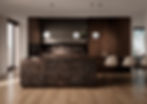.jpg)
Inspiration Guides
Transitional Kitchens
Transitional kitchens strike a balance between classic warmth and modern simplicity. They effortlessly blend old and new. If you love the timeless feel of a classic kitchen and appreciate the clean lines of modern design, this hybrid style may be your perfect match.
What Is a Transitional Kitchen Design?
Transitional kitchens merge traditional and contemporary elements. This might mean pairing shaker-style cabinets with sleek hardware, or combining natural stone countertops with handleless cabinets. The result is a kitchen that feels inviting and familiar—but with just enough modern polish to keep it feeling fresh.
The style is rooted in balance. It avoids extremes, steering clear of the ornate details found in traditional spaces and the stark minimalism of some modern interiors. Instead, it offers a comfortable, curated look that works well in open-concept homes and more formal layouts.
.jpg)
Key Design Elements
Cabinetry: Transitional kitchens often use flat-panel or shaker-style cabinets in soft neutrals like white, taupe, and light grey. Two-tone cabinetry—such as white uppers and natural wood base cabinets—is also typical.
Materials: Mixing is encouraged. Combine matte, gloss, metal, wood, or stone and laminate to create contrast and visual depth.
Color palette: Soft, natural hues dominate—beige, greige, or navy. Accents may include brushed brass, matte black, or occasionally a pop of color via a kitchen island.
Where Transitional Shines
One reason transitional kitchens are so popular is their flexibility. Depending on your home and preferences, they can be more traditional or more contemporary. You might layer in some mid-century modern furniture or opt for Scandinavian-inspired design to make the look your own.
These kitchens also excel at making use of mixed materials. A supermatt cabinet finish paired with wood grain or natural stone brings subtle texture without overwhelming the space.
Flooring and Layout
Hardwood or wood-look tile in light to medium tones works beautifully in transitional kitchens. Symmetry is key to layout. Islands are often a focal point, especially in open-concept homes, offering both function and an opportunity for contrast in color or material.
Storage tends to be innovative and concealed—think deep drawers, hidden pantry space, and custom inserts that preserve the clean look.
Lighting in Transitional Kitchens
Lighting plays a crucial role in setting the tone of a transitional kitchen. A mix of modern pendants and classic sconces can highlight the dual nature of the design. Consider layering ambient lighting with under-cabinet LEDs and statement fixtures above an island or dining table. The goal is to keep the space bright and welcoming, while showcasing architectural features and finishes without overpowering them.
Transitional kitchens are ideal for those who appreciate design with depth and flexibility. They offer enough tradition to feel timeless, but enough modern edge to stay current.
Want more inspiration? Browse our full range of kitchen remodeling projects or visit our NYC kitchen showroom in Queens to explore transitional kitchen displays in person.
.jpg)
.jpg)
.jpg)
.jpg)
%20(Large).jpg)
.jpg)
.jpg)



.jpg)

.jpg)
.jpg)
.jpg)
%20(Large).jpg)

.jpg)

%20(Large).jpg)

.jpg)
.jpg)

%20(Large)_edited.jpg)
.jpg)
.jpg)

_edited.jpg)
_edited.jpg)
.jpg)
%20(Large).jpg)